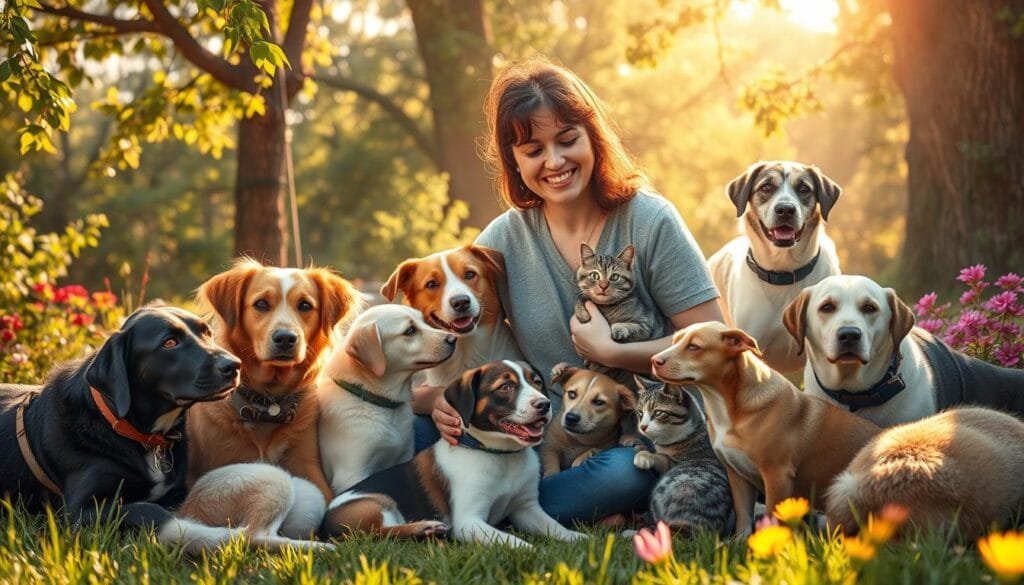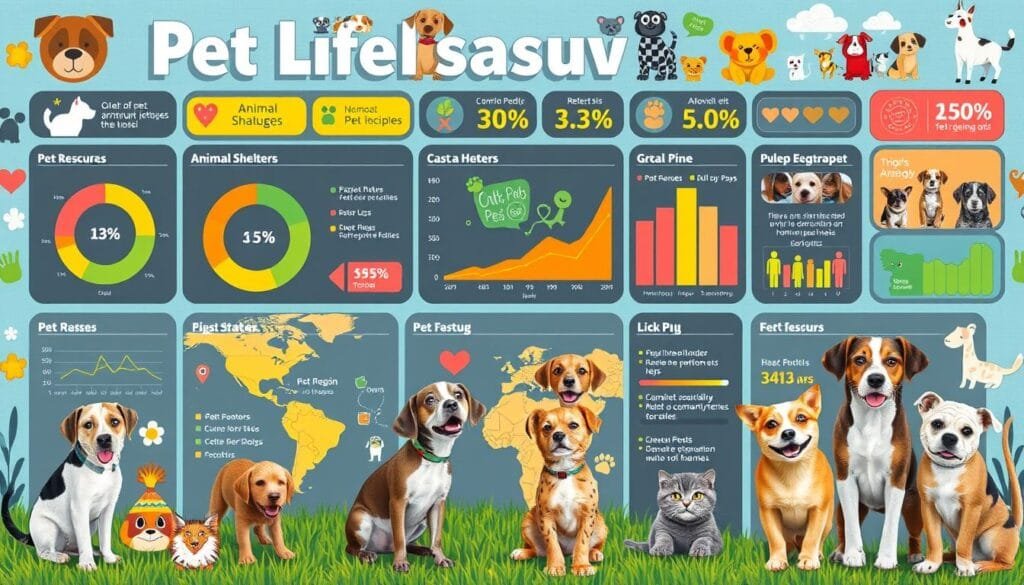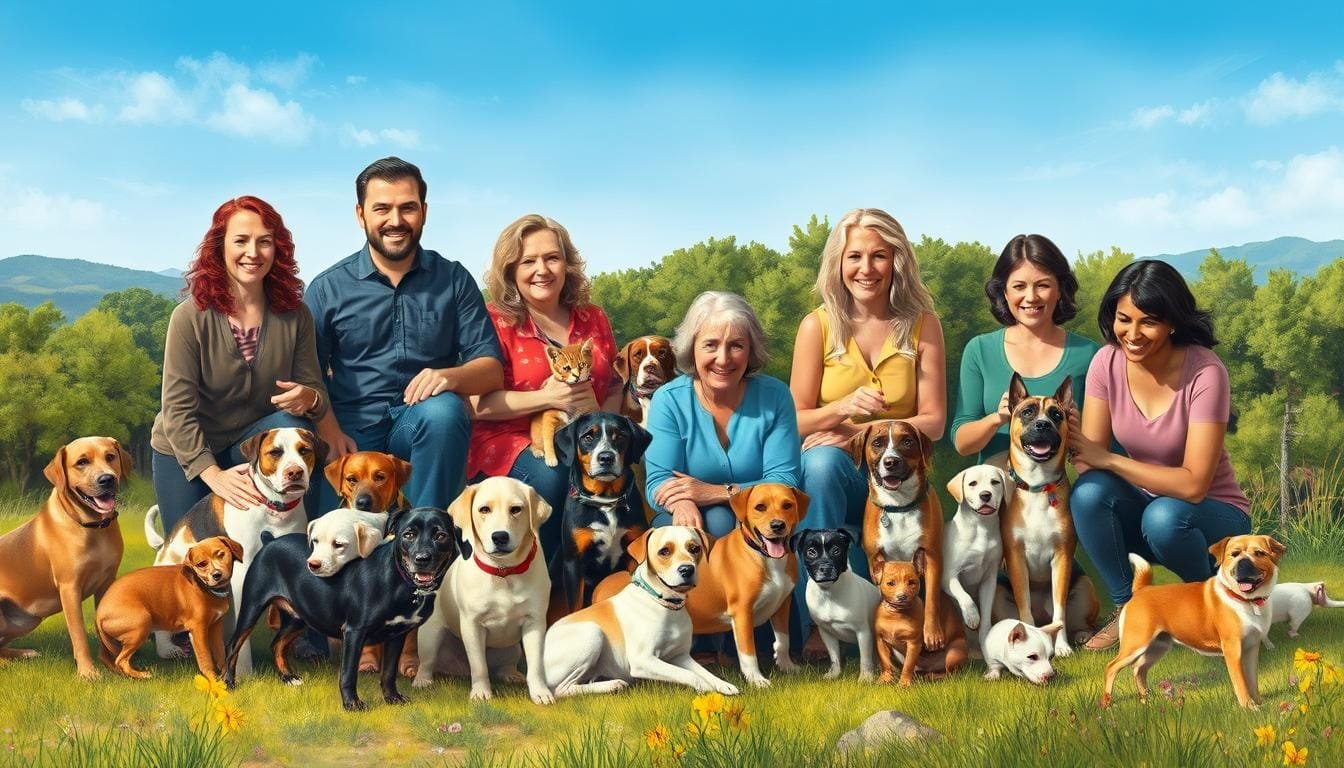In 1984, a group of visionaries formed an organization that would change animal welfare in America. They called it Best Friends Animal Society. It started as a safe place for homeless animals. Over time, it grew into a leading force in the no-kill movement. Francis Battista, Judah Battista, and Silva Battista were among the founders. They dedicated their lives to helping animals and started a nationwide effort to stop animal homelessness and euthanasia.
The history of Best Friends Animal Society is filled with determination and heart. These pioneers weren’t just animal lovers; they were game-changers. They wanted to do animal rescue differently. Using information from animal shelters, they created new tools and programs. Their goal was to better the lives of animals everywhere.
Their work has made a big difference and it’s still felt today. Through engaging with communities, embracing diversity, and offering mentorship, they’ve inspired over 5,000 groups to help. The story of Best Friends Animal Society motivates many. It moves us closer to a no-kill nation by 2025.
Key Takeaways
- Best Friends Animal Society was founded in 1984 by a dedicated group of animal welfare advocates.
- Founders like Francis Battista and Silva Battista played pivotal roles in shaping the organization’s mission.
- The organization is renowned for its innovative data-mapping tools and real-time data projects.
- Community engagement and mentorship have been integral to the society’s success.
- By 2025, Best Friends aims to achieve a no-kill status for all animal shelters in the U.S.
- The Best Friends Animal Society history showcases a journey from a sanctuary to a national movement.
Introduction to Best Friends Animal Society
Best Friends Animal Society is a leading figure in the no-kill movement. It aims to stop the killing of dogs and cats in American shelters. It began in 1984 with just 30 friends. Now, it has grown and employs nearly 800 people across the nation.
The main office is in Kanab, Utah. Here, Best Friends runs a large sanctuary that covers about 4,200 acres in Angel Canyon. It also has 17,000 acres on lease. The sanctuary houses 1,400 to 1,600 animals every day. They also lead in promoting pet adoptions and spay-and-neuter programs to cut down on animal homelessness.
Best Friends played a crucial role during Hurricane Katrina. It was among the first organizations to respond and the last to leave. Volunteers are key to their success. They contribute over 501,570 hours yearly to help the society’s initiatives across the US.
They launched a pet lifesaving dashboard that tracks every shelter in the US. This tool helps make them one of Fast Company’s top ten innovative companies. It’s a big step forward in the world of animal welfare.
Their effort to raise awareness for animal welfare has been pathbreaking. Before their work, info on US shelters and euthanized animals was limited. Their initiatives have filled this gap.
Through the Shelter Pet Data Alliance, Best Friends is bringing data transparency. This project provides up-to-date info by connecting with multiple shelter software vendors. This effort aids in their mission to save more lives.
Best Friends Animal Society is a leader in animal welfare. It has a network of over 5,000 groups across the country. Together, they work towards the no-kill movement. This teamwork creates a world where every animal can find a loving home.
The Visionary Founders
Best Friends Animal Society is a leading animal welfare organization in the U.S. It became what it is thanks to its visionary founders. They dreamed of a no-kill nation, attracting many supporters and volunteers. Francis Battista, Silva Battista, Gregory Castle, and others brought together their skills and dedication for animals. They laid the foundation for this amazing organization.
Francis Battista
Francis Battista was key in creating Best Friends Animal Society. His leadership and vision pushed the organization forward. His commitment set the base for what Best Friends is today.
Judah Battista
Judah Battista was crucial in the early days of Best Friends. His hands-on work and love for animals helped shape how the organization operates. He made sure every animal got the care they needed.
Silva Battista
Silva Battista played a big part as a founder of Best Friends Animal Society. She worked hard in community outreach and coordinating volunteers. Her work helped spread the word about the no-kill movement.
Gregory Castle
Gregory Castle, a co-founder, was deeply involved in growing Best Friends. His hard work and ideas led to many achievements. Castle’s efforts shaped the organization’s future and outreach.
Gabriel Depeyer
Gabriel Depeyer used his artistic talent and administrative skills for Best Friends. His creativity made the organization’s message of compassion and care stand out.
Jana Depeyer
Jana Depeyer provided important administrative support and dedication. Her work in management and community engagement was key for Best Friends in its early years.
Steven Hirano
Steven Hirano was an advocate for animal rights. His legal expertise and activism helped Best Friends navigate animal welfare laws. His contributions helped the organization grow its influence.
Faith Maloney
Faith Maloney showed incredible dedication, preparing food for 600 dogs daily for 11 years. She also helped start an animal sanctuary workshop. Faith led the editorial efforts of Best Friends magazine for 30 years.
Anne Mejia
Anne Mejia’s health and wellness programs were crucial for animal care at Best Friends. Her work in preventive health and rehabilitation set new care standards.
Cyrus Mejia
Cyrus Mejia combined art and activism to help Best Friends’ mission. His work included creating outreach materials and promoting a creative, empathetic culture within the organization.
| Year | Key Achievements | Financial Milestones |
|---|---|---|
| 2008 | Increased community involvement | Total assets grew by $596,713 |
| 2009 | Unprecedented fundraising success | Unrestricted net assets rose by $8,115,656 |
| 2015 | Major expansion of animal welfare programs | Contributions increased by $34,452,941 |
| 2016 | Broadening national influence | Net assets surged by $10,498,865 |
| 2017 | Enhanced operational efficiencies | Accounts receivable decreased by $2,248,849 |
Who is the founder of Best Friends Animal Society
The founders of Best Friends Animal Society were a group of people with a big dream. They included Francis Battista, Silva Battista, Gregory Castle, and more. They were all animal rescue pioneers.
“Our mission was clear: bring about a time when there are no more homeless pets,” says Francis Battista, co-founder.
In 1984, they started Best Friends Animal Society with a strong belief in no-kill advocacy. They put this belief into action in Kanab Canyon, Utah. There, they first cared for 200 homeless dogs and cats. The sanctuary grew quickly to help over 1,500 pets.

When Hurricane Katrina hit, Best Friends was the first to act. Led by Francis Battista, they saved more than 6,000 pets. This showed their leadership as animal rescue pioneers. The founders’ dedication lives on in many ways, including rescues, outreach, and promoting no-kill advocacy.
| Year | Milestone |
|---|---|
| 1984 | Best Friends Animal Society established |
| 2005 | Rescued over 6,000 pets during Hurricane Katrina |
| 2008 | Welcomed 22 dogs from Michael Vick’s dog fighting case |
The founders of Best Friends have not stopped making a difference. Their teamwork has led to big wins in animal welfare. Their work continues to inspire and bring change to animals’ lives.
The Early Years and Challenges
The Best Friends Animal Society history is filled with caring and community work. Started in the 1970s, around 20 million dogs and cats were killed each year in shelters. Facing big challenges, the founders pushed hard. They promoted no-kill policies, which was a new and widely argued idea at the time.
At first, the early challenges in animal welfare seemed huge. Best Friends Animal Sanctuary was on a 3,300-acre ranch in Kanab Canyon, Southern Utah. It opened in 1984. Remarkably, the sanctuary was up and running in six months. This was despite its remote location. They also had to get the community to believe in their mission. By 1984, about 200 animals had found a home at Best Friends.

The sanctuary quickly started to grow. Within a year, it was home to about 500 animals. The numbers kept growing, reaching 1,500 and more. Raising money was another challenge. They set up information booths in many cities, including Salt Lake City, Las Vegas, and Los Angeles. They focused on sharing positive stories and building relationships. This approach helped them win a lot of support from the public.
A major moment for Best Friends Animal Society was after Hurricane Katrina in 2005. They rescued over 6,000 pets in just a few months. This showed they could handle big emergencies. In 2008, they took in 22 dogs from Michael Vick’s dog fighting operation. This showed their deep commitment to no-kill policies and rehab for animals.
Thanks to their unwavering dedication, support and success grew. By 1991, nearly 2,000 animals were in their care. This growth put financial pressure on them but also led to more community support. Best Friends’ belief in no-kill has inspired animal welfare work worldwide, reaching countries like China, Korea, and Australia.
| Year | Significant Events |
|---|---|
| 1970s | Best Friends Animal Society was founded |
| 1984 | Establishment of animal sanctuary in Kanab Canyon, Utah |
| 1991 | Close to 2,000 animals under care, leading to financial struggles and fundraising |
| 2005 | Rescued over 6,000 pets following Hurricane Katrina |
| 2008 | Arranged care for 22 dogs from Michael Vick’s dog fighting ring |
The Evolution and Expansion of Best Friends Animal Society
Best Friends Animal Society grew by using technology and data to change animal rescue. They lead in saving animals with new strategies.
A Focus on Data and Technology
Best Friends always focuses on smart, data-driven choices. They’ve tracked shelter data since 2016, creating the Shelter Pet Data Alliance (SPDA). This helps give custom support.
This focus allows them to deal with challenges quickly. It helps shelters all over the country.
The Pet Lifesaving Dashboard
The pet lifesaving dashboard showcases their effort to use technology in animal welfare. Shelters can now see how well they are doing and aim for national goals. The goal is a 90% save rate by 2025, with the current rate at 69%.

Innovative Animal Welfare Tools
Apart from the dashboard, Best Friends Animal Society has created tools that have changed shelter operations. Because of technology, shelters like in NYC have increased adoption rates. They also plan to open a new center in New York City.
The Best Friends Network, with over 4,300 partners, offers various services. This network supports faster growth and helps the no-kill movement. Cities like Los Angeles are near a 90% save rate due to these efforts.
| Shelter/Partner | Annual Intake | Current Save Rate | Goals |
|---|---|---|---|
| Animal Care Centers of NYC | 30,000 | 94% | Decrease shelter intakes, pit bull rebranding |
| Oklahoma City Animal Welfare Shelter | 19,000 | N/A | No-kill status by 2025 |
| All Kind Animal Initiative | N/A | Increased cat lifesaving | Expand intake from other shelters |
The Impact of the No-Kill Movement
The no-kill movement, led by groups like Best Friends Animal Society, has changed animal welfare in the U.S. They work to lower euthanasia rates and increase adoptions. This movement has had a big impact.
In 2016, shelters in the U.S. euthanized nearly 2 million cats and dogs. Now, thanks to Best Friends Animal Society and others, that number is down to about 415,000 a year. Best Friends Animal Society runs the largest no-kill animal sanctuary in the U.S. They are also making progress toward making the whole country no-kill by 2025.
Recent data show that almost two-thirds of U.S. shelters are now no-kill. This is an all-time high. A staggering 85% of U.S. adults think no-kill shelters are important. A 90% save rate in shelters is a key goal for success in animal advocacy.
Less than 10% of pets in shelters have issues that prevent them from being rehomed. This makes the no-kill goal achievable with the right programs and partnerships.
Best Friends Animal Society aims to make the whole U.S. no-kill by 2025. They use spay/neuter services, adoptions, and foster programs to save lives. They also provide clear data to keep communities informed and involved. This helps local shelters meet no-kill standards.
To show the progress and goals, look at this data:
| Year | Number of Animals Killed | Shelters Achieving No-Kill (%) | National Save Rate (%) |
|---|---|---|---|
| 1984 | 17 million | — | — |
| 2016 | 2 million | — | — |
| 2022 | 378,000 | 57% | 81% |
| 2025 (Goal) | — | 100% | 100% |
The work of Best Friends Animal Society and other advocates strengthens the push for a no-kill nation. This ensures more animals find loving homes each year.
Partnerships and Community Engagement
Best Friends Animal Society focuses on building strategic partnerships and fostering deep community engagement. Initiatives like The Best Friends Network and The Embed Program allow us to work with local shelters. This way, we share resources, knowledge, and best practices.
The Best Friends Network
The Best Friends Network is key to engaging communities. It links animal welfare organizations across the nation. This facilitates resource sharing, problem-solving, and teamwork in improving animal welfare. The network is essential for collaboration, helping us promote a no-kill mission.
The Embed Program
The Embed Program deepens our partnerships by placing our staff in local shelters. Working closely with local teams, we offer direct support and guidance. This program boosts shelter operations, streamlines processes, and improves community engagement in animal welfare.
The Shelter Collaborative Programs
Our Shelter Collaborative Programs aim to extend our support. They connect established no-kill shelters with those working towards the goal. This spreads best practices and resources, helping lower euthanasia rates. These support programs drive a community-focused strategy, aiming for a safe future for all animals.
We emphasize collaboration and collective effort through our partnerships and community engagement initiatives. These efforts demonstrate the power of empowering local shelters. Together, we work towards the significant goal of making America no-kill by 2025.
Conclusion
Best Friends Animal Society shines as a source of hope in animal welfare. They have grown their influence from small beginnings. Their main goal is to stop pets from being killed in shelters. This dream has brought many people together to support their cause. Looking ahead, their commitment is making big changes for a no-kill future in the U.S. by 2025.
Their work isn’t just in the U.S., but all over the world since 2003. Best Friends has led programs in Asia, The Middle East, and Africa. They’ve teamed up with groups like the International Fund for Africa to tackle street dog issues in Ethiopia. Their aim is to prevent problems before they start. In 2009, they helped train locals in Ethiopia to make their program work.
This global effort shows how committed Best Friends Animal Society is. With support from people like Dr. Jane Goodall, they fight for animals everywhere. They focus on education, new ideas, and partnerships. This shows how big their impact is, and reminds us all to support no-kill shelters. Find out more about how animals sense the world and our role in their care here.
As Best Friends aims for a no-kill nation by 2025, we see real progress. More communities and people are joining this cause than ever before. Their work shows that together, we can make a difference. We can help every pet find a home where they are loved and safe.
FAQ
Who founded Best Friends Animal Society?
A: Francis Battista, Silva Battista, Gregory Castle, and others founded it. They all wanted to stop animals from being killed in shelters. They worked hard for animal welfare.
What is Best Friends Animal Society’s mission?
Their mission is to stop dogs and cats from being killed in shelters. They do this by promoting adoptions. And by supporting spay-and-neuter practices.
Where is Best Friends Animal Society headquartered?
It’s headquartered in Kanab, Utah.
What are some key achievements of the no-kill movement led by Best Friends Animal Society?
The no-kill movement has really helped animals in the U.S. Fewer animals are euthanized now, and more get adopted.
Best Friends has been a big influence. Many shelters and communities now follow no-kill principles because of them.
How does Best Friends Animal Society use technology to enhance its operations?
They use tech and data in cool ways to rescue more animals. The Pet Lifesaving Dashboard changed how shelters work together. It helps them save more lives.
What are The Best Friends Network and The Embed Program?
These are programs where Best Friends Animal Society works with local shelters. They share knowledge and resources. This way, they improve animal welfare together.
What challenges did Best Friends Animal Society face in its early years?
Early on, they had a tough time starting an animal sanctuary in a remote place. They also fought to make no-kill policies popular. It wasn’t easy back then.
What innovations has Best Friends Animal Society introduced to the field of animal welfare?
They’ve come up with many new ideas, like the Pet Lifesaving Dashboard. These tools help shelters work better together. And they save more animals’ lives.
How do Best Friends Animal Society’s partnerships benefit local shelters?
The partnerships give shelters resources and knowledge. This helps them take better care of animals and support no-kill efforts. It’s a big help for them.
What is the long-term vision for Best Friends Animal Society?
They dream of a no-kill nation where every dog and cat finds a home. They’re working to change the system to make this dream real across America.
